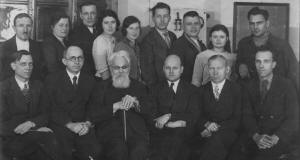

After Professor V.O. Hemilian, Yegor Ivanovich Orlov, an outstanding chemist and full member of the Academy of Sciences, was invited to work at the Institute. E.I. Orlov (14.11.1865 – 14.10.1944) graduated from Moscow University in 1894 and in 1894-1910 taught at the Kostroma Chemical Technology School, and in 1911-1927 worked as a professor and head of the Department (1911-1931) of Mineral Technology at the Kharkiv Institute of Technology (KTH). At the same time, he headed the Ukrainian Research Institute of Silicate Industry for 5 years, and from 1932 he was a professor at the Moscow Institute of Chemical Technology.
At KhTI, academician E.I. Orlov performed a number of important scientific studies. For example, his work “Formaldehyde, its extraction, properties and application” became the basis for the organisation of this production in Russia, and after its translation into German, plants are being built around the world using his method. The “Orlov reaction” for the production of liquid fuels from CO and H2 using catalysts is also well-known.
Academician E.I. Orlov’s scientific works are concerned with solving problems in chemical kinetics, technology of production of inorganic products, sulphuric acid, organic compounds, etc. He was the first to propose a mathematical model of negative catalysis and to develop the kinetic basis for the production of sulphuric acid and chlorine. Based on his research and design, the first formalin plant in Russia was built in 1909. E.I. Orlov is the author of many monographs on the production technologies of soda, silicates, and mineral pigments.
Academician E.I. Orlov was the first in the world to propose and investigate the production of H2SO4by the so-called “wet catalysis”; vanadium and chromium-vanadium catalysts for the production of H2SO4 at the stage of oxidation of SO2 to SO3 instead of platinum catalysts.

He was the organiser of the Research Institute of Refractories in Kharkiv. Kharkiv, which exists and is actively developing to this day.
At that time, the training of process engineers at the institute was increasing. In 1929, the Institute of Technology was reorganised into the Kharkiv Polytechnic Institute, and in 1930, the independent Kharkiv Institute of Chemical Technology and several other institutes were established on its basis.
The rapid development of the chemical industry required an increasing number of specialists who knew the industry in depth and in all its details, not just in general terms. The industry required such specialists to come to production and immediately take over the management of workshops and plants.
The number of students at the Kharkiv Institute of Technology increased dramatically. Thus, if in 1929-1930, 125 students were admitted to the first year, in 1933 – 256, and in 1938 – 325 students, and compared to 1910, the number of students increased almost 8 times.
The Department of Silicate Technology and the Department of Electrochemistry were spun off from the Department of Mineral Technology. A postgraduate course was organised at the department.
